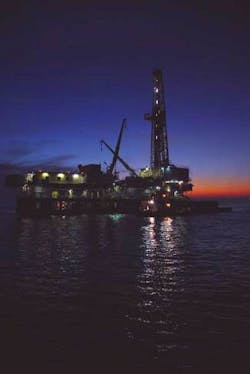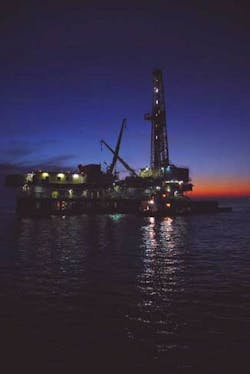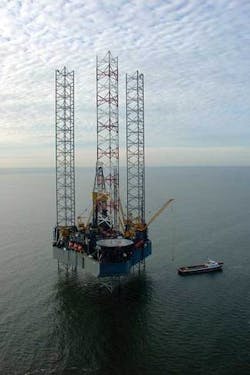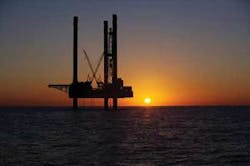The Gulf of Mexico shelf: still a cash flow machine
David Paganie, Managing Editor
Production continues to decline on the Gulf of Mexico shelf, but the cash keeps on flowing. Some refer to it as easy money, quick cash, money in your pocket. Shelf operators call it “cash flow.”
The GoM shelf is well known as a region characterized by rapid payout rates and excellent free cash flow generation. The production infrastructure is already in place, and commodity prices are favorable; so why are shelf assets still being sold? Is there still money to be made on the shelf? Is it feasible to drill deep shelf wells? These questions and others are answered as Offshore takes an exclusive inside look at three active independents who believe there is still a lot of money to be made on the GoM shelf.
But first, let’s look at some characteristics of the Gulf’s shallow-water region. The shelf, as defined by the Minerals Management Service, is the offshore area in less than 1,000 ft (305 m) of water. About 7.6% of total US oil production and 10.2% of US gas production is supplied from the shelf. Shallow-water production represents 29% of GoM oil and 63% of its gas.
According to MMS statistics, about half (3,606) of the active leases in the Gulf are on the shelf, and almost 4,000 platforms are active in the area. The number of leases issued in less than 656 ft (200 m) of water has been strong and consistent from 2001, but dropped off considerably from 464 issued in 2004 to 292 issued in 2006.
Production is forecast to continue to decline. The MMS estimates that shallow-water oil production will fall from a projected 329,000 b/d in 2007 to 182,000 b/d in 2016. Gas production is forecast to decline from an estimated 4.03 bcf/d in 2007 to 2.72 bcf/d in 2016.
Deep shelf gas production, on the other hand, is expected to remain flat from an estimated 1.07 bcf/d in 2007 through 2016. The deep shelf refers to wells drilled in shallow water to a TD below 15,000 ft (4,572 m). The MMS estimates that 55 tcf of undiscovered resources exist in this category.
As a result, incentives have been implemented to persuade operators to drill deep wells. Under an incentive established in 2004, qualifying leases earn a royalty suspension on the first 15 bcf of gas produced from a well to depths between 15,000 ft (4,572 m) and 18,000 ft (5,486 m) or on the first 25 bcf of gas produced from a well to 18,000 ft (5,486 m) or deeper. Drilling must have started on or after March 26, 2003, and production must begin before March 1, 2009.
The rule also establishes price threshold provisions, beginning at $9.34/MM-btu in 2004, which discontinues royalty relief if gas prices rise above that threshold. At print, the MMS was soliciting comment on a proposed provision (in accordance with the Energy Policy Act of 2005) to the rule. The provision extends deep gas royalty relief provisions from the current limit on leases to 656 ft (200 m) water depth to include leases to 1,312 ft (400 m) of water.
The proposed rule also raises the royalty suspension volume to 35 bcf for qualifying ultra-deep wells at least 20,000 ft (6,096 m) TVD in less than 1,312 ft (400 m) of water. This additional reliefwill apply only in years when the annual NYMEX gas price is at or below $4.47/MMbtu expressed in 2006 dollars.
Meanwhile, 22% (mean of 19.31 Bboe) of the region’s undiscovered technically recoverable resources lie in less than 656 ft (200 m) of water.
Apache Corp.
Houston-based Apache Corp. has built its GoM shelf core area over the past 15 years through $2.7 billion in acquisitions of producing assets, according to Steven Farris, Apache president and CEO. The company has drilled more than 350 wells on the acquired properties and re-invested in the Gulf more than $2.3 billion of the $6.2 billion of cash flow generated in the region, Farris says.
- Active shelf leases: 477
- Shelf production: Gross: 70,000 b/d oil, 700 MMcf/d gas; Net: 45,000 b/d oil, 435 MMcf/d gas
- Shelf wells drilled in 2006: 61 gross wells, 7 >15,000 ft deep
- Shelf wells projected to spud in 2007: 65 gross wells, 10 >15,000 ft deep
The company has acquired shelf assets over the years from Shell, Occidental Petroleum, Hall Houston, BP, and Anadarko. It closed its $845-millon acquisition of 13 fields with 44 MMboe from BP in 2006.
In 2007, Apache estimates it will spend $630 million on exploration and production on the shelf. “We’re increasing our capex because service costs have gone up. We’re drilling deeper, and drilling more,” says John Jeppesen, Apache senior vice president and leader of its Gulf Coast region. “We’ll probably drill 65 wells offshore this year.”
Shelf strategy
Apache likes the way the Gulf is shaping up. “We’re having a very active year,” Jeppesen says. “We’re running anywhere from 10-12 rigs in the jackup and platform markets. Jackup rates have dropped about 50% (in the Gulf). Rig availability is currently not a problem. Service costs have moderated. And, by mid-summer, we’ll be pretty much recovered from hurricanes Katrina and Rita.”
After the hurricanes, the company’s net offshore production averaged about 24,000 b/d of oil and 300 MMcf/d of gas. Currently, its net production is up to 45,000 b/d of oil and 435 MMcf/d of gas.
When asked what makes the shelf attractive, Jeppesen says, “Tremendous cash flow. We get the oil and gas out of the ground quickly. Different regions in our company do different things; here, we are the cash flow generator.”
While the company is generating sufficient cash flow from its conventional shelf operations, it is now looking to other areas for additional income.
“The shelf will be our cash flow generator for a while, but we’re also acquiring a lot of brand new seismic data, and we’re looking at our acreage deeper,” Jeppesen says. “We’re taking a fresh look at the deeper potential in and around our producing fields. Rather than just use the same old data off the shelf, we’re spending quite a bit of money on new data and reprocessed data.”
With this data, the company plans to put more emphasis on exploration. “It’s not a real shift, we’re going to keep doing what we’re doing, but we’re adding an exploration focus to our portfolio,” Jeppesen explains. “We’re going to be doing more trend and deep shelf exploration.”
The company has limits on how deep it will go, however. “We’re picky about where we look on the deep side. We’re not going ultra-deep. We’re not drilling anything below 20,000 ft (6,096 m). That’s out of our league. Most of our deep wells will be 15,000 to 18,000 ft (4,572 to 5,486 m) deep, which are very reasonable drill depths mechanically. We’re not into pressing the envelope in drilling technology. In our book, those are science projects,” Jeppesen says.
While deep drilling is expected to be the new trend on the shelf, Jeppesen also thinks assets will continue to change hands. “Oh yes, it will be constant,” he says. “A number of the big boys have already left. There will be some more. There’s a lot of money chasing this business.”
W&T Offshore Inc.
Similar to Apache, Houston-based W&T Offshore has been building its shelf inventory through acquisitions. Since 1999, the company has acquired 590 bcfe of reserves. This includes the company’s lastest, and largest acquisition ever.
In 2006, W&T closed its $1.03-billion acquisition of Kerr-McGee’s shelf properties, which includes 100 fields on 249 blocks with 247 bcfe.
And the company plans to continue buying assets, says Tracy Krohn, founder, chairman, CEO, and president of W&T. “That’s kind of bread and butter for us, and there are still a lot of reserves to find on the shelf.” The company already struck pay this year on High Island block 24 on the conventional shelf. The first two wells tested 42 MMb/d of oil and 50 MMcf/d of gas, respectively.
W&T has allocated $353 million for exploration and development drilling in 2007 for 18 wells, nine of which are on the shelf.
Shelf strategy
Like most operators on the shelf, cash flow is the number one attraction to W&T. “It’s not a philosophical question, it’s a dollar question,” Krohn says.
“We’re a cash generating machine; that’s what we do. The fact that oil and gas happens to be the product is really just parcel to the fact that we’re looking for cash. We get the cash out of the ground real quick, put it back in, and then we do it again. That’s the real point - we really can replace reserves, and we do. We focus on cash returns.” The company holds about 2 million gross acres in the GoM.
Like Apache, W&T isn’t having problems finding rigs. “We haven’t had any issues getting jackups. There are still plenty of rigs in the Gulf. I keep hearing that rigs are leaving the Gulf, but I’m not feeling the effects.”
Beyond conventional shelf drilling, W&T sees potential on the deep shelf, Krohn explains. “The concept of the deep shelf in the GoM is particularly enticing for us. I still think there’s a lot of money to be made out on the shelf and deep shelf, and I think the deep shelf will become increasingly more important. One of the good things about the deep shelf is that once you find something, it doesn’t take long to bring it online. We’re talking about months instead of years. And that’s the really big attraction.”
While W&T and others are moving into deepwater to search unexplored basins, Krohn thinks there’s another unexplored area in the Gulf. “I think the next big frontier in the GoM is going to be ultra-deep shelf drilling. By that, I mean wells in excess of 20,000 to 30,000 ft (6,096 to 9,144 m). The first time someone drills a well 30,000 to 35,000 ft (6,096 to 10,668 m) deep and makes a big discovery, everyone is going to look at you differently.”
The industry, however, needs to develop better technology to reduce risk, Krohn says.
“Drilling to 25,000 ft (7,620 m) is a pretty reasonable depth to get to right now. In excess of that, I think we need to develop more technology with metals and fluids, and we’re going to have to figure out how to manage pressure drilling.”
With all of the opportunity available in the GoM, W&T is not planning to branch out from the Gulf any time soon.
“We’re here (GoM). We’re going to be here for a long time, and we’ve been here for a long time. I think we’ll stay for a while, and if other opportunities rear their ugly little heads, then we’ll try to take advantage of them,” Krohn says.
McMoRan Exploration Co.
McMoRan, active in the GoM since 1969, is one of the oldest players on the shelf. The company has rights to about 360,000 gross acres in the area.
- Active shelf leases: 390
Shelf production (1Q 2007): - Gross: 10,945 b/d oil, 199 MMcf/d gas;
- Net: 70 MMcfe/d
- Shelf wells drilled in 2006 (>15,000 ft deep/<15,000 ft deep): 11/2
- Shelf wells projected to spud in 2007 (>15,000 ft deep/<15,000 ft deep): 6-8/2
- Note: All data is for onshore and offshore shelf operations
McMoRan plans to build on the success of its two deep Miocene discoveries this year. Laphroaig (onshore in St. Mary Parish, Louisiana) flowed 41 MMcf/d of gas, 16 MMcf/d net to McMoRan. And Hurricane Deep in South Marsh Island block 217 in 12 ft (3.7 m) of water, was drilled to 20,712 ft (6,313 m) TVD and logged 40 ft (12 m) of net pay in a 53-ft (16-m) interval. The well also logged “exceptionally” thickgyro sands, which suggests the company’s prospects in Mound Point, JB Mountain, Hurricane, and Blueberry Hill, could have substantial gyro reservoirs.
McMoRan has budgeted $150 million for exploration and development in 2007. Of that amount, $100 million is allocated for 8-10 exploration wells during the year. At print, the company was drilling five wells on the shelf: one to 15,000 ft (4,572 m) TD, one to greater than 15,000 ft (4,572 m) TD, and three to greater than 20,000 ft (6,313 m) TD, with one of the three proposed to reach 25,000 ft (7,620 m) TD.
Shelf strategy
McMoRan’s shelf strategy is to locate deep Miocene structures on the Gulf of Mexico shelf. James “Jim Bob” Moffett, co-chairman, McMoRan, explains, “A significant number of wells have been drilled below 15,000 ft (4,572 m) onshore, and only 5% of the wells drilled in the GoM have reached this depth. Our strategy is to take this area that has been sparsely drilled and apply basic 3D geology that paints the age of the structures. We’re looking for major fields with anywhere from 100 bcf to 1 tcf of gas. We think this is one of the most unexplored areas in the world.”
The main challenge to locating deep reserves, explains Moffett, is the right interpretation of seismic data.
“Starting in the early ’70s, the bright spot method of exploration worked great in the Plio-Pleistocene structures,” Moffett says. “But, when you get to Miocene, especially the deep Miocene, where the rocks are older and the depths and pressure is greater, bright spot is not reliable. Frankly, you have to go back to old-fashioned geology to work the deep Miocene.”
McMoRan is using the old-fashioned data to plan its wells.
“We’re basically using a 3-D database that was used for bright spots in the Plio-Pleistocene, to locate the deep Miocene structures,” Moffett says. “It doesn’t have the same odds as conventional shelf wells, but the targets are big. If you are right and you strike a big sand, you can get high rates of production to pay for these expensive wells.”
Other independents, Moffett says, tried to find deep reserves with bright spots, but got mixed results.
“Drilling the so-called bright spot anomalies just has not been as successful as people hoped it would. Too many anomalies turned out to be non-hydrocarbons, and other anomalies were misleading in terms of sand thickness. It turns out that the so called bright spot risk factors go up exponentially as you go below pressure and the deeper rocks, because they’re denser and they just don’t have the same physical characteristics.”
Moffett points out that the Miocene formation on the shelf exists in deepwater as well. In his opinion, however, there are advantages to targeting the formations in shallow water versus deepwater.
“The completion costs on the shelf are one-tenth the cost of deepwater, and wells can be brought online in less than six months because the platform and pipeline infrastructure is already in place,” he says. “Drilling on the shelf costs 25% to 30% of what it costs to drill in deepwater. A $30-million well on the shelf can pay out in two to four months. It’s a very simple strategy. The deep Miocene in deepwater and the deep Miocene on the shelf are exactly the same; the rest is Economics 101.”
The GoM shelf is a huge cash flow generator, says Moffett. “If you can locate big columns in thick sands, which can produce high flow rates, then the economics of the shelf is the best you can find.”
A good place to find shallow-water Plio-Pleistocene or Miocene trends, Moffett explains, is to start at the coastline.
“Knowledge of the onshore stratigraphic section is the best way to find where the sands are,” he says. “The Delta, which has been built over the coastline, has had a lot of deep drilling, and you can take the benefit of those wells and project them out into the shelf area. If you find something, you can follow it parallel to the coastline, and then you can define a trend 20 to 40 mi (32 to 64 km) wide that represents the old coastline. If this works, everyone is going to think we’re geniuses.”
Legacy majors
Majors have been gradually leaving the GoM shelf over the years for bigger targets with longer RP profiles both onshore and in deepwater.
The latest majors to leave the shelf were BP and Kerr-McGee in 2006. However, Chevron and ExxonMobil are still two of the biggest players in the area. Chevron holds 202 producing leases in less than 400 m (1,312 ft) of water, and its production through October 2006 totaled 63.04 Bboe.
ExxonMobil holds 57 active leases in this water depth range, and its production for the same period was 19.42 Bboe. In 2006, Chevron drilled 70 development and delineation wells and five exploration wells below 15,000 ft (4,572 m) deep, while ExxonMobil drilled only four. During 2006, Chevron average 69,000 b/d of oil net, 622 MMcf/d of gas, and 10,000 b/d of natural gas liquids.
According to Qiana Wilson, spokeswoman for Gulf of Mexico SBU, Chevron North America E&P Co., “Chevron holds an intensive acreage position in the central GoM shelf and will continue to pursue opportunities, particularly where the acreage lies adjacent to or beneath existing Chevron production leases.”
New player
The latest entrant into the GoM shelf melting pot is Bermuda-based Energy XXI (Bermuda) Ltd. The company has entered into an agreement with Pogo Producing Co. to purchase Pogo’s shelf properties for $419.5 million in cash.
The transaction includes 28 fields currently producing 7,400 net boe/d, with net proved reserves of 20 MMboe. Leases included cover 282,000 gross acres, or 91,600 net acres (1,141 sq km gross, 371 sq km net).
“This transaction will boost our recent production run rate by more than 40% and our proved reserve base by about 50%,” says John Schiller, chairman and CEO, Energy XXI.
“Given current oil and gas prices, we consider this an attractive investment based solely on the proved properties, and we expect the deal to be immediately accretive to cash flow.”
The transaction was expected to close by June 1, subject to customary closing conditions and adjustments.
Meanwhile, Energy XXI expected to be listed on the NASDAQ by the end of June. The US Securities and Exchange Commission accepted the company’s application to trade 115 million shares of its common stock. The company is also listed on London Stock Exchange’s AIM.









